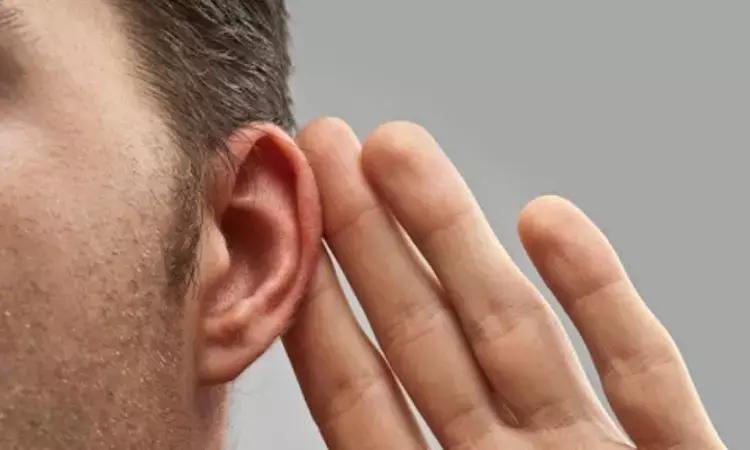- Home
- Medical news & Guidelines
- Anesthesiology
- Cardiology and CTVS
- Critical Care
- Dentistry
- Dermatology
- Diabetes and Endocrinology
- ENT
- Gastroenterology
- Medicine
- Nephrology
- Neurology
- Obstretics-Gynaecology
- Oncology
- Ophthalmology
- Orthopaedics
- Pediatrics-Neonatology
- Psychiatry
- Pulmonology
- Radiology
- Surgery
- Urology
- Laboratory Medicine
- Diet
- Nursing
- Paramedical
- Physiotherapy
- Health news
- Fact Check
- Bone Health Fact Check
- Brain Health Fact Check
- Cancer Related Fact Check
- Child Care Fact Check
- Dental and oral health fact check
- Diabetes and metabolic health fact check
- Diet and Nutrition Fact Check
- Eye and ENT Care Fact Check
- Fitness fact check
- Gut health fact check
- Heart health fact check
- Kidney health fact check
- Medical education fact check
- Men's health fact check
- Respiratory fact check
- Skin and hair care fact check
- Vaccine and Immunization fact check
- Women's health fact check
- AYUSH
- State News
- Andaman and Nicobar Islands
- Andhra Pradesh
- Arunachal Pradesh
- Assam
- Bihar
- Chandigarh
- Chattisgarh
- Dadra and Nagar Haveli
- Daman and Diu
- Delhi
- Goa
- Gujarat
- Haryana
- Himachal Pradesh
- Jammu & Kashmir
- Jharkhand
- Karnataka
- Kerala
- Ladakh
- Lakshadweep
- Madhya Pradesh
- Maharashtra
- Manipur
- Meghalaya
- Mizoram
- Nagaland
- Odisha
- Puducherry
- Punjab
- Rajasthan
- Sikkim
- Tamil Nadu
- Telangana
- Tripura
- Uttar Pradesh
- Uttrakhand
- West Bengal
- Medical Education
- Industry
Hearing and dual sensory loss tied to all-cause, cardiovascular mortality: JAMA

Singapore: In a new study conducted by Benjamin Kye Jyn Tan and the team, it was found that excess all-cause mortality was linked to hearing loss (HL) and dual sensory loss (DSL). The findings of this study were published in the Journal of American Medical Association.
Hearing loss (HL) and dual sensory loss (DSL) are common, debilitating, and linked to a variety of age-related illnesses, such as dementia and frailty. There is currently no evidence-based overview of their mortality risk. As a result, the goal of this study was to determine the epidemiological links between HL/DSL and death.
PubMed, Embase, and the Cochrane Library were searched for this study from inception to June 18, 2021. Two blinded reviewers chose observational or interventional studies that reported the presence or severity of HL or DSL, whether objectively measured or self-reported, in accordance with any mortality estimate in adults 18 years and older, and were published as full-length English articles in peer-reviewed journals. Following the Preferred Reporting Items for Systematic Reviews and Meta-Analyses (PRISMA)/Meta-analysis of Observational Studies in Epidemiology (MOOSE) standards and a PROSPERO-registered procedure, two reviewers gathered data and assessed research bias using the Newcastle-Ottawa Scale. Hazard ratios (HRs) for all-cause, cardiovascular, and other mortality estimations were the key outcomes.
The key findings are as follow:
1. From 3220 data, 14 retrospective and 13 prospective observational studies (1 213 756 people) were included in this evaluation.
2. The risk of bias was low to moderate, and the results were unaffected by the deletion of three high-risk studies.
3. After adjusting for demographics and comorbidities, hearing loss was linked to higher risks of all-cause and cardiovascular mortality, whereas DSL was linked to higher risks of all-cause and cardiovascular mortality.
4. Prespecified meta-regression adequately explained heterogeneity, with prolonged follow-up time decreasing the pooled link and leaving low residual heterogeneity (29 percent).
5. A dose-response relationship was discovered using meta-regression across audiometric studies (doubling of HR per 30-dB increase in HL).
6. The impact sizes of self-reported and audiometric measures were similar, with the latter having less heterogeneity.
7. Trim-and-fill adjustments for publication bias and single-study effects, as well as cumulative meta-analyses, had no effect on the associations.
8. With just 1 to 3 studies, associations with accident/injury, cancer, and stroke mortality were equivocal. The overall quality of the evidence was moderate.
In conclusion, there was a dose-response relationship, with the relative risk of all-cause death doubling for every 30-dB rise in audiometric thresholds; when both hearing and vision loss were present, the additional all-cause and cardiovascular mortality was considerably greater, at 40% and 86 percent, respectively. Physicians who treat individuals with HL should think about how it affects their overall health and longevity.
Reference:
Tan BKJ, Ng FYC, Song HJJMD, Tan NKW, Ng LS, Loh WS. Associations of Hearing Loss and Dual Sensory Loss With Mortality: A Systematic Review, Meta-analysis, and Meta-regression of 26 Observational Studies With 1 213 756 Participants. JAMA Otolaryngol Head Neck Surg. Published online December 30, 2021. doi:10.1001/jamaoto.2021.3767
Medical Dialogues consists of a team of passionate medical/scientific writers, led by doctors and healthcare researchers. Our team efforts to bring you updated and timely news about the important happenings of the medical and healthcare sector. Our editorial team can be reached at editorial@medicaldialogues.in.
Dr Kamal Kant Kohli-MBBS, DTCD- a chest specialist with more than 30 years of practice and a flair for writing clinical articles, Dr Kamal Kant Kohli joined Medical Dialogues as a Chief Editor of Medical News. Besides writing articles, as an editor, he proofreads and verifies all the medical content published on Medical Dialogues including those coming from journals, studies,medical conferences,guidelines etc. Email: drkohli@medicaldialogues.in. Contact no. 011-43720751


